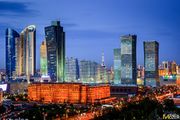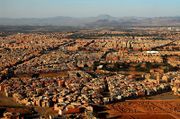Difference between revisions of "Kostromastan"
Tuvaltastan (Talk | contribs) (→History) |
Tuvaltastan (Talk | contribs) |
||
| Line 55: | Line 55: | ||
|calling_code = +18 | |calling_code = +18 | ||
}} | }} | ||
| − | '''The | + | '''The Confederation of Kostromastan''', commonly known as [[Kostromastan]], is a landlocked nation that exists on the continent Aurora that borders Baykalia and [[Xiopothos]] to the north, Tuvaltastan to the south, Ethalria to the west, and [[Caltharus]] to the northwest. Kostromastan exists between the latitudes 28 S and 40 S, and between the longitudes 120 E and 140 E. The nation, with a Nominal GDP per capita of $14,425, has an estimated population of 20,003,248. The largest city and capital Novgorod holds 12,768,513 individuals, 63.8% of the population. |
The History of Kostromastan is greatly intertwined with its neighbors [[Baykalia]] and [[Tuvaltastan]], and goes back as far as 1,700 B.C.E., beginning with the Ancient Kostuvians and their immense empire that encompassed central Aurora and a number of small islands north and south of the continent, as well as part of what is now modern-day Dragonia. The [[Kostuvian Empire]] existed for 1,032 years, and was succeeded by [[Kostuvastan]] in 12 A.D. Kostuvastan existed for 1,973 years until the three major culture groups (Baykalians, Tuvalts, and Kostros) began the [[Kostuvastan Civil War]]. The three culture groups, after the Civil War, founded the three nations Tuvaltastan, Kostromastan, and Baykalia. | The History of Kostromastan is greatly intertwined with its neighbors [[Baykalia]] and [[Tuvaltastan]], and goes back as far as 1,700 B.C.E., beginning with the Ancient Kostuvians and their immense empire that encompassed central Aurora and a number of small islands north and south of the continent, as well as part of what is now modern-day Dragonia. The [[Kostuvian Empire]] existed for 1,032 years, and was succeeded by [[Kostuvastan]] in 12 A.D. Kostuvastan existed for 1,973 years until the three major culture groups (Baykalians, Tuvalts, and Kostros) began the [[Kostuvastan Civil War]]. The three culture groups, after the Civil War, founded the three nations Tuvaltastan, Kostromastan, and Baykalia. | ||
| Line 61: | Line 61: | ||
==Etymology== | ==Etymology== | ||
| − | The word "Kost" directly stems from the original Kostuvastan, while the "rom" in the name originates from "romia," which translates to "desert" in Codexian and " | + | The word "Kost" directly stems from the original Kostuvastan, while the "rom" in the name originates from Ancient Kostuvian's "romia," which translates to "desert" in Codexian and "صحراء" in Kostuvian. |
==History== | ==History== | ||
Revision as of 17:59, 30 May 2017
| The Confederation of Kostromastan | ||||
|---|---|---|---|---|
|
||||
| Motto: Motto Unavailable | ||||
| Anthem: "O Beautiful Kostromastan" | ||||
Green: Kostromastan ; Light Green: The ACA
|
||||
| Capital and largest city | Novgorod | |||
| Official languages | Codexian and Kostuvian | |||
| Ethnic groups (2015 Estimate) | 89.8% Human
8.2% Lupine 2% Other |
|||
| Demonym | Kostrom, Kostromi, Kostro, Kostromastani, Kostromastanian | |||
| Government | Confederation | |||
| - | President | Albert Lewinsky | ||
| - | Vice President | Romov Wazlonski | ||
| - | Lead of the Cabinet | Robert Orevon | ||
| Legislature | Congress | |||
| - | Upper house | House | ||
| - | Lower house | Senate | ||
| Area | ||||
| - | Total | 610,600 km2 N/A sq mi |
||
| Population | ||||
| - | 2015 estimate | 20,003,248 | ||
| - | 2010 census | 19,164,355 | ||
| - | Density | N/A/km2 N/A/sq mi |
||
| GDP (nominal) | 2015 estimate | |||
| - | Total | $288.56 billion | ||
| - | Per capita | $14,425 | ||
| Gini (2016) | 31.2 medium |
|||
| HDI (2016) | .689 medium |
|||
| Currency | Kirib (♅) |
|||
| Date format | MM/DD/YYYY | |||
| Drives on the | the right | |||
| Calling code | +18 | |||
| ISO 3166 code | KOS | |||
| Internet TLD | .kos | |||
The Confederation of Kostromastan, commonly known as Kostromastan, is a landlocked nation that exists on the continent Aurora that borders Baykalia and Xiopothos to the north, Tuvaltastan to the south, Ethalria to the west, and Caltharus to the northwest. Kostromastan exists between the latitudes 28 S and 40 S, and between the longitudes 120 E and 140 E. The nation, with a Nominal GDP per capita of $14,425, has an estimated population of 20,003,248. The largest city and capital Novgorod holds 12,768,513 individuals, 63.8% of the population.
The History of Kostromastan is greatly intertwined with its neighbors Baykalia and Tuvaltastan, and goes back as far as 1,700 B.C.E., beginning with the Ancient Kostuvians and their immense empire that encompassed central Aurora and a number of small islands north and south of the continent, as well as part of what is now modern-day Dragonia. The Kostuvian Empire existed for 1,032 years, and was succeeded by Kostuvastan in 12 A.D. Kostuvastan existed for 1,973 years until the three major culture groups (Baykalians, Tuvalts, and Kostros) began the Kostuvastan Civil War. The three culture groups, after the Civil War, founded the three nations Tuvaltastan, Kostromastan, and Baykalia.
Etymology
The word "Kost" directly stems from the original Kostuvastan, while the "rom" in the name originates from Ancient Kostuvian's "romia," which translates to "desert" in Codexian and "صحراء" in Kostuvian.
History
Separation of Kostuvastan
(See Kostuvastan)
Beginnings of Kostromastan
Kostromastan, along with Tuvaltastan, were officially independent on the day October 17th, 2005. The newly-formed nation spent 21 months writing the constitution, due to the fact that not every province, particularly the Astrak and Tula provinces, was happy with each new iteration of the constitution. It was continually refined, until on July 12th, 2007, the Kostrom Constitution was finally offically ratified. It basically established an umbrella government of the five provinces that more or less manages the five provinces. Most governmental activities, however, take place withing provincial borders. The only activities that the national government takes part in are larger advisory, congressional, parliamentary, and executive issues such as civil rights and constitutionality of bills, as well as some foreign affairs. However, not every issue is handled by the national government, some examples of this being the admission of some Kostrom provinces while others not joining, and the Kost-Tuva War, in which the northern provinces did not participate.
Modern-Day Kostromastan
Being landlocked, Kostromastan relies greatly on its neighbors for access to international trade. Due to this, 87% of its trade takes place within Aurora and ACA members.
The Kost-Tuva War (2009-2010)
This war was between Tuvaltastan and Kostromastan, and lasted 11 months before ending on a peace treaty that ended the war. It was catalyzed by many skirmishes between Kostro and Tuvalt civilians along the northern portion of Tuvaltastan and the eastern corner of Kostromastan caused by a border dispute between the two countries, with Kostromastan claiming an area that would allow the nation to no longer be landlocked. Eventually, politicians in Tuvaltastan called for a war to settle the border dispute. The Hall approved of the war, and the conflict killed approximately 12,000 Tuvalts and 11,000 Kostros. The war also resulted in Tuvaltastan keeping its northern border with Xiopothos, and leaving Kostromastan to be the only landlocked nation on Aurora.
Politics
Governmental System
Every position in every branch of government is elected through the people by representatives. Each candidate is given ♅10,000 to campaign with, and most candidates also accept donations from individuals and organizations such as activist groups and companies.
Executive Branch
The Executive Branch is made up of a council of five Presidents (one for each province), who vote whether to pass or veto bills proposed by Congress or Parliament.
Congressional Branch
The Congressional Branch is a legislative branch of government that discusses bills sent from Parliament. The bills that get approved are sent to the Executive Branch, and also makes those bills passed by the Executive Branch into law. Before it is passed, it must be screened by the Advisory Branch beforehand. Congress is made up of 25 members, five members for each province.
Parliamentary Branch
The Parliamentary Branch is where most of the dirty work takes place, per se. The Provincal Legislatures send their representatives (number of representatives per province is based on population: 1 Representative per 250,000 people) to Parliament with the proposed bills from each province, and discuss the bills proposed. The proposed bills that get approved by Parliament are sent to Congress and the Advisory Branch.
Advisory Branch
The Advisory Branch determines whether a proposed bill follows the Constitutional standards.
Domestic Policy
Each province has dominion over their own territory, and have their own laws and constitutions.
Foreign Policy
Kostromastan has multiple embassies, being in All Auroran Continental Assembly member nations, Stratarin, Tretrid, and The Three States of Fortuna.
Electoral Process
Military
(Main article: Military of Kostromastan)
The military makes up 15% of Kostromastan's governmental budget of $46.9 billion, which is approximately $7.035 Billion.
| Military Branch | Funding | |
|---|---|---|
| Ground Forces | $4,500,000,000 | |
| Subterran Forces | $1,299,000,000 | |
| Air Forces | $1,236,000,000 | |
Culture
Food
Customs and Traditions
Literature
Music
Festivities
Holidays
Geography
Climate
Kostromastan is engulfed in a desert. The only places where life can survive is along the Salov River, which runs through the entirety of Kostromastan. The only city that is not along the Salov is Tula, which is an experimental city that studies and tests new technologies and prototypical concepts.
Ecosystem
Due to the entirety of the country being in a desert, there are few living things. A small number of desert animals and plants do exist however, which include the burrowing desert mole, the trelik plant, the Polinski rat, and the drilling worm. Interestingly, the drilling worm was the inspiration behind the Subterran Forces in former Kostuvastan.
Economy
Agriculture
Most food is imported from other nations, Tuvaltastan being the largest provider of livestock. There are efforts to minimize imports of food, pushed by a few activist groups. None of these groups have made it far into the national government, however.
Industry
The primary industries in Kostromastan revolve around mining and design. The mines of Kostromastan predominantly extract platinum, iron, zinc, and copper.
Science and Technology
Kostromastan has not been as fortunate as its fellow former Kostuv territories, and has duly been behind in technological and scientific advancements. Nonetheless, there has been a very successful effort to curb smog in Kostrom cities, and as a result Volgoda, Novgorod, Tula, and Nal'Chik are at least 90% powered by renewable energy.
Demographics
| City Name | Population of City | |
|---|---|---|
| Total | 20,003,248 | |
| Novgorod | 12,768,513 | |
| Volgoda | 4,317,942 | |
| Nal'chik | 1,273,541 | |
| Tula | 1,004,762 | |
| Astrakhan | 638,490 | |
Ethnicity
| Ethnicity | Population of Ethnicity | |
|---|---|---|
| Total | --- | |
| Human | --- | |
| Lupine | --- | |
| Tuvalt | --- | |
| Baykalian | --- | |
| Xiopothan | --- | |
Religion
| Religion | Population of Religion | |
|---|---|---|
| Catholicism | --- | |
| Buddhism | --- | |
| Unaffiliated | --- | |
| Clarityism | 50 | |







